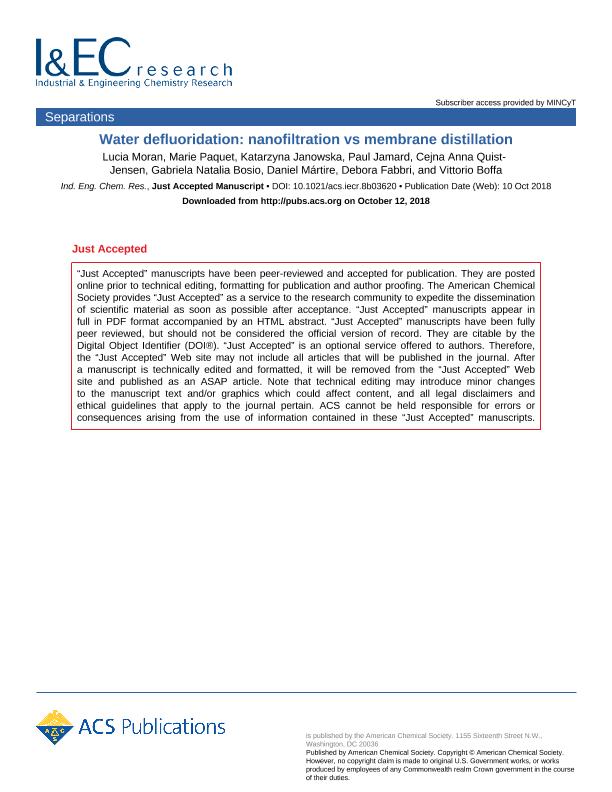Artículo
Water Defluoridation: Nanofiltration vs Membrane Distillation
Moran Ayala, Lucia Isabel ; Paquet, Marie; Janowska, Katarzyna; Jamard, Paul; Quist Jensen, Cejna A.; Bosio, Gabriela Natalia
; Paquet, Marie; Janowska, Katarzyna; Jamard, Paul; Quist Jensen, Cejna A.; Bosio, Gabriela Natalia ; Martire, Daniel Osvaldo; Fabbri, Debora; Boffa, Vittorio
; Martire, Daniel Osvaldo; Fabbri, Debora; Boffa, Vittorio
 ; Paquet, Marie; Janowska, Katarzyna; Jamard, Paul; Quist Jensen, Cejna A.; Bosio, Gabriela Natalia
; Paquet, Marie; Janowska, Katarzyna; Jamard, Paul; Quist Jensen, Cejna A.; Bosio, Gabriela Natalia ; Martire, Daniel Osvaldo; Fabbri, Debora; Boffa, Vittorio
; Martire, Daniel Osvaldo; Fabbri, Debora; Boffa, Vittorio
Fecha de publicación:
10/2018
Editorial:
American Chemical Society
Revista:
Industrial & Engineering Chemical Research
ISSN:
0888-5885
Idioma:
Inglés
Tipo de recurso:
Artículo publicado
Clasificación temática:
Resumen
Nowadays, fluoride contamination of drinking water is a major problem for various countries, because high concentrations of fluoride pose a risk of dental and skeletal fluorosis. Over past years, membrane nanofiltration (NF) has been proposed as convenient defluoridation technology. However, NF cannot be applied to water systems with high fluoride concentration, and the disposal of the membrane concentrate remains an issue. In this work, we compared a commercial polyester NF membrane and a polypropylene hollow-fiber membrane distillation (MD) module for their ability to remove fluoride ions from water in the presence of hardness ions and organic fouling agents. The NF membrane can offer more than 10 times higher water productivity than MD, under realistic gradients of temperature and pressure, respectively. Despite that, after reaching a concentration factor of about 3, fouling and scaling caused the flux to drop to about 80% with respect to its initial value. Moreover, F- retention decreased from 90% to below 80%, thus providing a permeate of scarce quality. MD was operated in the direct-contact mode on a polypropylene hollow-fiber membrane, which was charged with a hot feed flow (average T = 58 °C) on one side and a cooled (20 °C) permeate flow of distilled water on the other side. The concentration of fluoride ions in the permeate was always below the detection limit of our electrode (0.2 ppm), regardless of the fluoride concentration in the feed. Moreover, the MD module showed higher resistance to fouling and scaling than NF, and CaF2 crystals were recovered from the MD concentrate after cooling. These results suggest that the synergic combination of the two techniques might be beneficial for the purification of fluoride-contaminated water systems: MD can be used to further concentrate the NF retentate, thus producing high-purity water and recovering CaF2 crystals.
Palabras clave:
Membrana de Destilacion
Archivos asociados
Licencia
Identificadores
Colecciones
Articulos(INIFTA)
Articulos de INST.DE INV.FISICOQUIMICAS TEORICAS Y APLIC.
Articulos de INST.DE INV.FISICOQUIMICAS TEORICAS Y APLIC.
Citación
Moran Ayala, Lucia Isabel; Paquet, Marie; Janowska, Katarzyna; Jamard, Paul; Quist Jensen, Cejna A.; et al.; Water Defluoridation: Nanofiltration vs Membrane Distillation; American Chemical Society; Industrial & Engineering Chemical Research; 57; 43; 10-2018; 14740-14748
Compartir
Altmétricas



